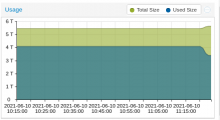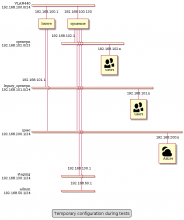- Queries
- All Stories
- Search
- Advanced Search
- Transactions
- Transaction Logs
Advanced Search
Jun 10 2021
- configuration of the swh-search and journal clients services deployed
- Old node decommissionning on the cluster:
export ES_NODE=192.168.100.86:9200
curl -H "Content-Type: application/json" -XPUT http://${ES_NODE}/_cluster/settings\?pretty -d '{
"transient" : {
"cluster.routing.allocation.exclude._ip" : "192.168.100.81,192.168.100.82,192.168.100.83"
}
}'
{
"acknowledged" : true,
"persistent" : { },
"transient" : {
"cluster" : {
"routing" : {
"allocation" : {
"exclude" : {
"_ip" : "192.168.100.81,192.168.100.82,192.168.100.83"
}
}
}
}
}
}The shards start to be gently moved from the old servers:
curl -s http://search-esnode4:9200/_cat/allocation\?s\=host\&v 10:22:58
shards disk.indices disk.used disk.avail disk.total disk.percent host ip node
27 38.7gb 38.8gb 153.7gb 192.6gb 20 192.168.100.81 192.168.100.81 search-esnode1
27 37.7gb 37.8gb 154.8gb 192.6gb 19 192.168.100.82 192.168.100.82 search-esnode2
22 30.5gb 30.6gb 162gb 192.6gb 15 192.168.100.83 192.168.100.83 search-esnode3
35 50gb 50.1gb 6.6tb 6.7tb 0 192.168.100.86 192.168.100.86 search-esnode4
35 50gb 50.2gb 6.6tb 6.7tb 0 192.168.100.87 192.168.100.87 search-esnode5
34 49.4gb 49.5gb 6.6tb 6.7tb 0 192.168.100.88 192.168.100.88 search-esnode6When they will be no shards on the old servers, we will be able to stop them and remove them from the proxmox server.
Jun 9 2021
And all the new nodes are now in the production cluster:
curl -s http://search\-esnode4:9200/_cat/allocation\?s\=host\&v 35m 9s 18:47:23
shards disk.indices disk.used disk.avail disk.total disk.percent host ip node
30 42.7gb 42.9gb 149.7gb 192.6gb 22 192.168.100.81 192.168.100.81 search-esnode1
30 41.4gb 41.6gb 151gb 192.6gb 21 192.168.100.82 192.168.100.82 search-esnode2
30 41.7gb 41.8gb 150.8gb 192.6gb 21 192.168.100.83 192.168.100.83 search-esnode3
30 41.9gb 42gb 6.6tb 6.7tb 0 192.168.100.86 192.168.100.86 search-esnode4
30 41.8gb 41.9gb 6.6tb 6.7tb 0 192.168.100.87 192.168.100.87 search-esnode5
30 41.2gb 41.3gb 6.6tb 6.7tb 0 192.168.100.88 192.168.100.88 search-esnode6The next step will be to switch the swh-search configurations to use the new nodes and progressively remove the old nodes from the cluster.
- zfs installation:
root@search-esnode4:~# apt update && apt install linux-image-amd64 linux-headers-amd64 root@search-esnode4:~# shutdown -r now # to apply the kernel root@search-esnode4:~# apt install libnvpair1linux libuutil1linux libzfs2linux libzpool2linux zfs-dkms zfsutils-linux zfs-zed
- refresh with the last packages installed from backports
root@search-esnode4:~# apt dist-upgrade # trigger a udev upgrade which leads to a network interface renaming root@search-esnode4:~# sed -i 's/ens1/enp2s0/g' /etc/network/interfaces
- pre zfs configuration actions:
root@search-esnode4:~# puppet agent --disable root@search-esnode4:~# systemctl disable elasticsearch root@search-esnode4:~# systemctl stop elasticsearch root@search-esnode4:~# rm -rf /srv/elasticsearch/nodes
- To manage the disks via zfs, the raid card needed to be configured in enhanced HBA mode in the idrac
- after a rebbot, the disks are well detected by the system:
root@search-esnode4:~# ls -al /dev/sd* brw-rw---- 1 root disk 8, 0 Jun 9 04:54 /dev/sda brw-rw---- 1 root disk 8, 16 Jun 9 04:54 /dev/sdb brw-rw---- 1 root disk 8, 32 Jun 9 04:54 /dev/sdc brw-rw---- 1 root disk 8, 48 Jun 9 04:54 /dev/sdd brw-rw---- 1 root disk 8, 64 Jun 9 04:54 /dev/sde brw-rw---- 1 root disk 8, 80 Jun 9 04:54 /dev/sdf brw-rw---- 1 root disk 8, 96 Jun 9 04:54 /dev/sdg brw-rw---- 1 root disk 8, 97 Jun 9 04:54 /dev/sdg1 brw-rw---- 1 root disk 8, 98 Jun 9 04:54 /dev/sdg2 brw-rw---- 1 root disk 8, 99 Jun 9 04:54 /dev/sdg3
root@search-esnode4:~# smartctl -a /dev/sda smartctl 6.6 2017-11-05 r4594 [x86_64-linux-4.19.0-16-amd64] (local build) Copyright (C) 2002-17, Bruce Allen, Christian Franke, www.smartmontools.org
Jun 8 2021
Jun 4 2021
Jun 3 2021
I played with grid5000 to experiment how the jobs work and how to initialize the reserved nodes.
lgtm
Jun 2 2021
- The fix was deployed on webapp1 and moma
- The refresh script was manually launched:
root@webapp1:~# /usr/local/bin/refresh-savecodenow-statuses Successfully updated 140 save request(s).
The previous requests were correctly refreshed and are now displaying the right status.
Will be deployed with version v0.0.310 of the webapp (build in progress)
fix typo in commit message
Jun 1 2021
May 28 2021
The OPNsense firewall configuration was finalized based on the initial configuration olasd has previously done on the OPNsense firewalls.
May 27 2021
The save code now queue statistics are now displayed on the status.io page[1] as an example. The data are refreshed each 5 minutes.
May 26 2021
update python script:
- remove some prints
- add missing types
- use dict access instead of get
May 25 2021
The servers should be installed on the rack the 26th May. The network configuration will follow the same day or next day.
They will be installed as it by the "DSI" so we will have to install the system via the iDRAC when they will be reachable.
With a master declared in the dns, everything seems to work well.
when the docker command is launched on a node, it's status is well detected and the node is correctly configured after a couple of minute.
The cluster explorer is also working now.
Metrics can easily be pushed to the status page.
The simple poc for the save code now request is available here : https://forge.softwareheritage.org/source/snippets/browse/master/sysadmin/status.io/update_metrics.py
May 20 2021
The basic installation with helm is simple for a mono server installation: https://rancher.com/docs/rancher/v2.5/en/installation/install-rancher-on-k8s/#install-the-rancher-helm-chart
for the status.swh.org point of view, status.io is providing some api endpoint to push metrics. It should be possible to add some metrics (up to 10 with our plan) to expose the behavior of the platform (daily/weekly and monthly statistics).
As a first step, we could expose the number of pending save code now requests and the number of origin visits to have some live data. An example of a status page with metrics : https://status.docker.com/
I'm working on a code snippet to test the integration feasibility/complexity.
great simplification ! thanks
LGTM
May 19 2021
After some hard time with vagrant internal and pergamon configuration, we finally have a puppet master working.
The collected resources are well detected and applied, for example here, with the logstash0's incinga resources :
Notice: /Stage[main]/Profile::Icinga2::Master/Icinga2::Object::Host[pergamon.softwareheritage.org]/Icinga2::Object[icinga2::object::Host::pergamon.softwareheritage.org]/Concat[/etc/icinga2/zones.d/master/pergamon.softwareheritage.org.conf]/File[/etc/icinga2/zones.d/master/pergamon.softwareheritage.org.conf]/ensure: defined content as '{md5}e98c7cafc5300df8101f591d1c7a708b'
Info: Concat[/etc/icinga2/zones.d/master/pergamon.softwareheritage.org.conf]: Scheduling refresh of Class[Icinga2::Service]
Notice: /Stage[main]/Profile::Grafana::Vhost/Icinga2::Object::Service[grafana http redirect on pergamon.softwareheritage.org]/Icinga2::Object[icinga2::object::Service::grafana http redirect on pergamon.softwareheritage.org]/Concat[/etc/icinga2/zones.d/master/exported-checks.conf]/File[/etc/icinga2/zones.d/master/exported-checks.conf]/content:May 18 2021
and the build is green ;)
thanks for having investigated that
May 17 2021
May 12 2021
May 11 2021
May 10 2021
Theses errors will be caught by the alert created in T3222

